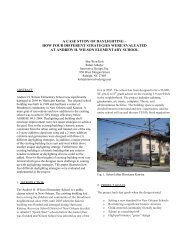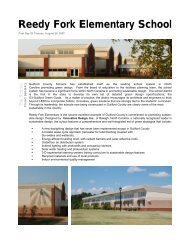SOLAR TODAY - May 2011 - Innovative Design
SOLAR TODAY - May 2011 - Innovative Design
SOLAR TODAY - May 2011 - Innovative Design
Create successful ePaper yourself
Turn your PDF publications into a flip-book with our unique Google optimized e-Paper software.
SunShot Boosts NREL’s<br />
Incubator Program<br />
Not all SunShot funding went toward<br />
the projects at 1366 Technologies,<br />
3M, PPG, Varian Semiconductor and<br />
Veeco, a fifth recipient. Another $7 million<br />
was injected into the National Renewable<br />
Energy Lab’s Photovoltaic (PV) Technology<br />
Incubator program.<br />
Started in 2009, the incubator program<br />
is primarily tasked with hastening<br />
nascent PV technologies’ transition from<br />
the drawing board into the lab. There<br />
are two funding tiers: The first supports<br />
the development of commercially viable<br />
prototypes; the second helps companies<br />
scale up to the pilot-project manufacturing<br />
stage. The latest funding targeted the<br />
four companies below.<br />
Tier One<br />
Caelux — $1 million<br />
Caelux of Pasadena, Calif., is developing<br />
a flexible PV-manufacturing process that<br />
minimizes the amount of semiconducting<br />
material used.<br />
Solexant — $1 million<br />
Solexant of San Jose, Calif., is developing<br />
a new printable nanoparticle thin-film ink<br />
from common nontoxic substances.<br />
Stion — $1 million<br />
Stion of San Jose, Calif., is developing a<br />
technology consisting of two stacked<br />
high-efficiency thin-film devices, offering<br />
improved absorption of light.<br />
Tier Two<br />
Crystal Solar — $4 million<br />
Crystal Solar of Santa Clara, Calif., is commercializing<br />
single-crystal silicon wafers,<br />
four times thinner than standard cells.<br />
Arnie Funkenbusch and Tracie Berniard, of 3M’s renewable energy division, with a roll of 3M Ultra Barrier<br />
Solar Film. The Maplewood, Minn.-based company was awarded $4.4 million in SunShot funding to scale<br />
up manufacturing of the film in February.<br />
able Energy Laboratory (NREL). Using feedback<br />
from NREL and the CIGS module manufacturers,<br />
Funkenbusch expects the redesign to have<br />
increased light transmission, better durability and<br />
lower cost. “What we want to do is make sure we<br />
have a product that lasts 25 years,” Funkenbusch<br />
says. “That’s where SunShot helps us out.”<br />
The new manufacturing line will go in at an<br />
existing 3M factory in Columbus, Mo. According<br />
to the Columbus Daily Tribune, the line will<br />
add 120 jobs to a plant that’s shed jobs for years.<br />
Construction of the line is underway and production<br />
is set to begin in early 2012. There are<br />
indications that CIGS module manufacturer<br />
SoloPower, which recently secured a $197 million<br />
DOE loan guarantee for a new factory in<br />
Wilsonville, Ore., will be the first customer.<br />
Varian Semiconductor<br />
Target: IBC Cell Production, Expense<br />
Recent NREL tests have measured SunPower’s<br />
interdigitated-back-contact solar (IBC) cells<br />
at the highest conversion efficiencies to date. The<br />
principle is very simple: IBC cells eliminate frontside<br />
metallic conductors, which typically cover 5<br />
to 8 percent of the physical surface of a wafer.<br />
Move the wiring to the backside, more sunlight<br />
gets absorbed, and cell efficiency spikes.<br />
The only factor preventing IBC PV from<br />
becoming the industry standard is cost.<br />
“Currently, IBC solar has the highest efficiencies,<br />
but it’s very expensive to make,” says<br />
Jim Mullin, general manager for solar products<br />
at Varian Semiconductor (vsea.com). “In solar<br />
manufacturing, every step adds cost, adds complexity,<br />
and can result in potential yield loss.” In<br />
Gloucester, Mass., Mullin and his associates at<br />
Varian are using $4.8 million in SunShot funding<br />
to develop an ion-implant tool that promises to<br />
slash the number of manufacturing steps from<br />
21, necessary in the conventional IBC process<br />
today, to eight.<br />
Ion implantation is far from a novel concept<br />
— implanters are integral to semiconductor<br />
device fabrication and have long been used<br />
to make computer chips. Varian’s been selling<br />
the tools to the electronics industry since 1975<br />
and has an ion implanter, the Varion Solion, for<br />
conventional PV cells that’s already running in<br />
high-volume production. SunShot backing will<br />
be used to redesign the Solion to give it the capability<br />
to do backside wafer patterning necessary<br />
for IBC cell production. No manufacturer has<br />
attempted it. “We’re the first ones to do this,”<br />
Mullin says. “We are in a unique position because<br />
we’re the only ones that can really do it without<br />
impacting the tool’s productivity — because we<br />
own the intellectual property.”<br />
Mullin says that Varian has matched its DOE<br />
funding with internal investments well north of<br />
$20 million. He expects the tool to be commercially<br />
ready within three years.<br />
It’s unclear how much the reduction in production<br />
complexity will reduce IBC costs. Module<br />
manufacturers have some ground to make<br />
up before IBC solar is cost-competitive with<br />
other PV technologies. San Jose, Calif.-based<br />
SunPower is the only company commercially<br />
producing IBC modules today and is operating<br />
at a production cost of around $1.70 per watt.<br />
Chinese crystalline-silicon manufacturers are<br />
producing at about $1.20 per watt, while First<br />
Solar, a CdTe thin-film manufacturer, is now<br />
down below the $0.75 mark. ST<br />
3M<br />
Copyright © <strong>2011</strong> by the American Solar Energy Society Inc. All rights reserved.<br />
solartoday.org <strong>SOLAR</strong> <strong>TODAY</strong> <strong>May</strong> <strong>2011</strong> 41









